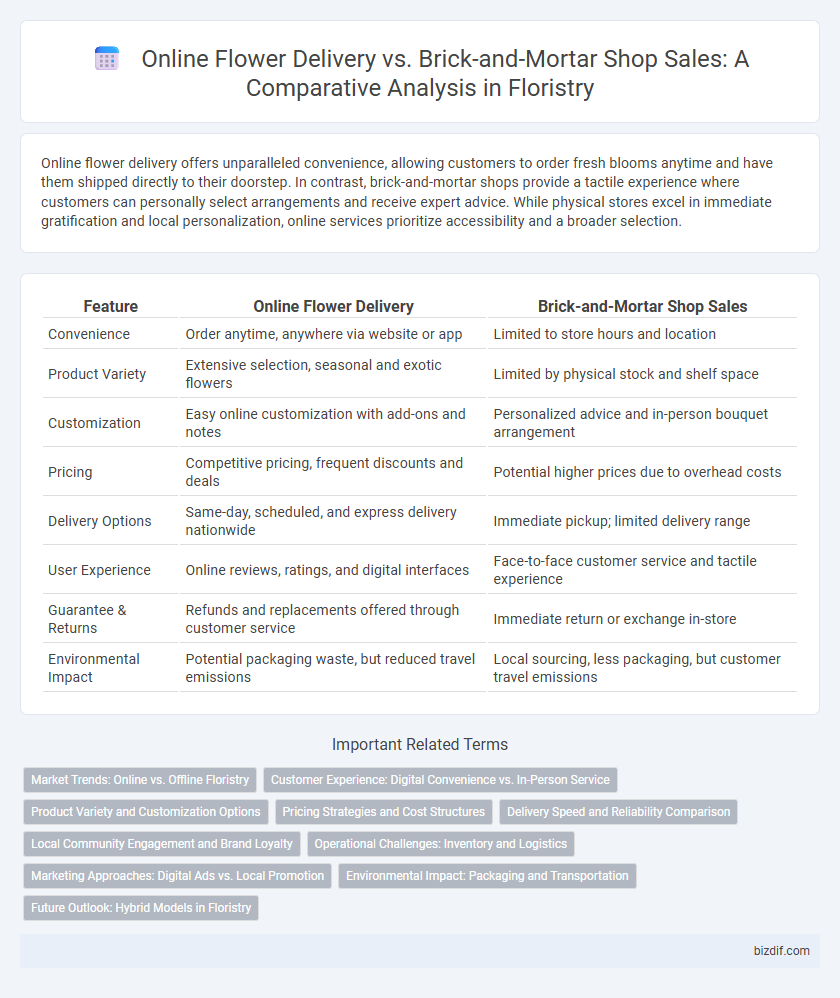Online flower delivery offers unparalleled convenience, allowing customers to order fresh blooms anytime and have them shipped directly to their doorstep. In contrast, brick-and-mortar shops provide a tactile experience where customers can personally select arrangements and receive expert advice. While physical stores excel in immediate gratification and local personalization, online services prioritize accessibility and a broader selection.
Table of Comparison
| Feature | Online Flower Delivery | Brick-and-Mortar Shop Sales |
|---|---|---|
| Convenience | Order anytime, anywhere via website or app | Limited to store hours and location |
| Product Variety | Extensive selection, seasonal and exotic flowers | Limited by physical stock and shelf space |
| Customization | Easy online customization with add-ons and notes | Personalized advice and in-person bouquet arrangement |
| Pricing | Competitive pricing, frequent discounts and deals | Potential higher prices due to overhead costs |
| Delivery Options | Same-day, scheduled, and express delivery nationwide | Immediate pickup; limited delivery range |
| User Experience | Online reviews, ratings, and digital interfaces | Face-to-face customer service and tactile experience |
| Guarantee & Returns | Refunds and replacements offered through customer service | Immediate return or exchange in-store |
| Environmental Impact | Potential packaging waste, but reduced travel emissions | Local sourcing, less packaging, but customer travel emissions |
Market Trends: Online vs. Offline Floristry
Online flower delivery has surged, driven by convenience and expanding e-commerce platforms, capturing a growing market share globally. Brick-and-mortar florists maintain relevance through personalized service, in-store experiences, and same-day local delivery options. Market trends indicate a hybrid approach combining digital presence with physical outlets enhances customer reach and sales.
Customer Experience: Digital Convenience vs. In-Person Service
Online flower delivery offers unparalleled convenience with 24/7 ordering, real-time tracking, and wide selection accessible from any device, enhancing customer experience through seamless digital interfaces. Brick-and-mortar shops provide personalized, tactile interactions, allowing customers to see flower arrangements firsthand and receive expert advice tailored to specific occasions. The choice between digital convenience and in-person service ultimately depends on customer preferences for immediacy and sensory engagement in floristry purchases.
Product Variety and Customization Options
Online flower delivery services offer an extensive product variety, including exotic blooms and seasonal arrangements, often unavailable in brick-and-mortar shops. Customization options online enable customers to easily tailor bouquets with specific flower types, colors, and personalized messages through user-friendly interfaces. Physical stores, while limited in stock variety due to space constraints, provide hands-on design input and immediate floral freshness assurance.
Pricing Strategies and Cost Structures
Online flower delivery services typically lower overhead costs by eliminating physical storefront expenses, allowing competitive pricing and dynamic discounts that attract budget-conscious customers. Brick-and-mortar flower shops incur higher fixed costs such as rent, utilities, and in-person staff wages, often resulting in higher base prices but offering personalized service and immediate product access. E-commerce platforms leverage bulk purchasing and optimized logistics to reduce costs, whereas traditional shops emphasize quality and local sourcing, influencing distinct pricing strategies in the floristry market.
Delivery Speed and Reliability Comparison
Online flower delivery services often leverage advanced logistics networks to ensure faster and more reliable same-day or next-day deliveries compared to brick-and-mortar shops. Many online florists provide real-time tracking and automated dispatch systems, enhancing delivery accuracy and customer satisfaction. Conversely, traditional flower shops may face limitations in coverage area and delivery scalability, affecting speed and consistency during peak seasons.
Local Community Engagement and Brand Loyalty
Local community engagement through brick-and-mortar flower shops fosters stronger brand loyalty by providing personalized customer experiences and supporting neighborhood events. Online flower delivery services optimize convenience and reach but often lack the tangible connection that cultivates deep community ties. Combining digital outreach with in-store events can enhance local brand presence and customer retention in floristry.
Operational Challenges: Inventory and Logistics
Online flower delivery faces significant operational challenges in inventory management due to perishable stock requiring precise demand forecasting and rapid turnover, unlike brick-and-mortar shops which can adjust inventory in real-time through direct customer interaction. Logistics complexity increases for online sales with the need for refrigerated transportation and last-mile delivery coordination to ensure freshness, whereas physical stores benefit from immediate product availability and direct customer pickup. Efficient inventory systems leveraging real-time data analytics and integrating supply chain visibility are crucial for online florists to minimize waste and meet delivery expectations.
Marketing Approaches: Digital Ads vs. Local Promotion
Online flower delivery services leverage targeted digital ads on platforms like Google and Facebook to reach a broad audience, optimizing sales through personalized offers and data-driven campaigns. Brick-and-mortar florists concentrate on local promotion by sponsoring community events, using direct mailers, and building relationships with nearby customers to drive in-store traffic. Both marketing approaches aim to maximize customer engagement but differ fundamentally in scale and personalization strategies.
Environmental Impact: Packaging and Transportation
Online flower delivery often relies on extensive packaging materials, including plastic wraps and foam inserts, which can increase environmental waste compared to the minimal packaging used by brick-and-mortar shops. Transportation for online orders typically involves long-distance shipping and express courier services, leading to higher carbon emissions than local pickups from physical stores. Sustainable floristry practices encourage using biodegradable packaging and optimizing delivery routes to reduce the carbon footprint associated with both sales models.
Future Outlook: Hybrid Models in Floristry
Hybrid models integrating online flower delivery with brick-and-mortar shop sales represent the future of floristry by combining convenience and personalized customer experiences. These models leverage advanced e-commerce platforms alongside physical storefronts to offer real-time customization, same-day local delivery, and interactive consultations. Market trends indicate that florists adopting hybrid approaches can increase customer retention by up to 30% and drive revenue growth in a highly competitive floral industry.
Online flower delivery vs brick-and-mortar shop sales Infographic

 bizdif.com
bizdif.com